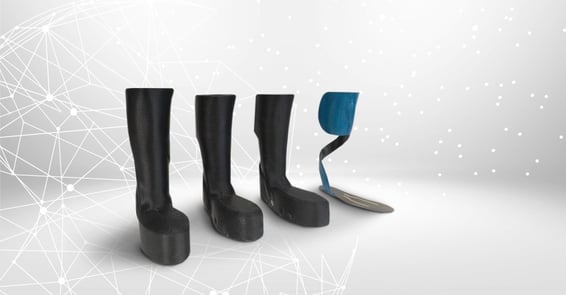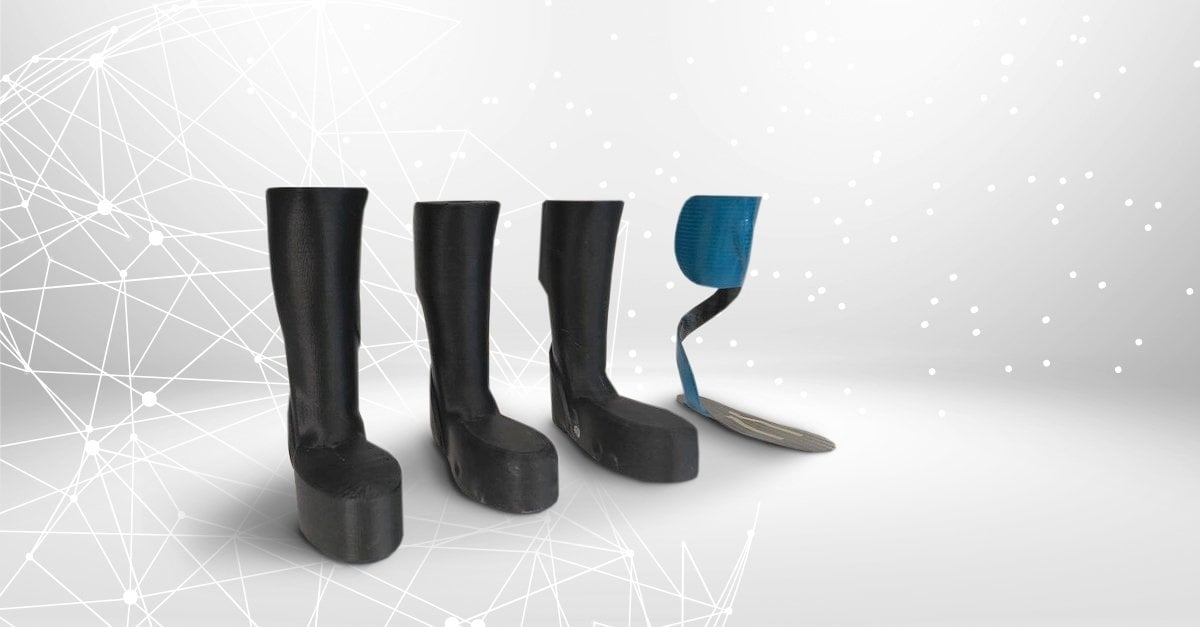Additive manufacturing in orthopedic technology: 3D printing for perfectly customized orthotics

When manufacturing high-quality orthoses, filament 3D printing (3F) offers significant advantages over conventional manufacturing processes. There are no compromises in terms of the quality of the end product.
In addition to the excellent quality, you also benefit from a high process speed, a significantly reduced use of materials and thus lower production costs. How can you take advantage of the advantages mentioned by using additive manufacturing? You will find out in this post.
Orthosis manufacturer adViva improves its manufacturing process
In cooperation with the software manufacturer Teton Simulation, the 3D printer manufacturer Ultimaker and the specialty plastics manufacturer LEHVOSS Group, the Heidelberg-based manufacturer of orthoses adViva has fundamentally revised the process of manufacturing patient-specific orthoses made of carbon fiber-reinforced thermosetting plastics. Significant process advantages could be achieved with the use of 3D printing.
The four partners behind the innovative manufacturing process
adViva, a health company founded in Heidelberg in 1997, develops and produces patient-specific aids such as orthoses and prostheses for the usual care of patients - including for competitive athletes. With its advice and services, adViva forms the interface to the customer.
With "SmartSlice", the US software developer Teton Simulation offers a plug-in that optimizes both the performance during operation and the print setting for the form. In this way, the SmartSlice ensures that the printed part meets the performance requirements on the one hand and that printing time and material consumption are minimized on the other.
Founded in 2011 in the USA, Ultimaker is a provider of 3D printing system solutions consisting of printers, software and materials.
With its thermoplastic LUVOCOM 3F PET CF 9780 BK, the LEHVOSS Group offers a material that is characterized by its high strength, heat resistance, excellent surface quality when printing, easy printability and recyclability. The material can be collected separately and completely returned to technical plastics recycling within the scope of a material return without any sort.
Classic orthotic production can be improved with additive manufacturing
For decades, the machining of semi-finished products has formed the core of the manufacturing process for molds for classic orthoses. This process is divided into 3D scanning, shape design, cutting the block material to the milling standard, machining (milling), lamination, curing and demolding.
Cutting and milling have a number of characteristic, ecologically relevant aspects:
- There are large amounts of cutting residues as well as fine and extremely fine dust.
- A considerable amount of cleaning work is required in production rooms and filter systems.
- The inclusion of foreign material on laminated components poses a risk of possible loss of quality.
- Any dust, block sections and the lamination form must be disposed of as hazardous waste.
The set-up activities cutting and milling thus offer the greatest potential for optimization in order to reduce the overall process to relevant steps, to reduce the use of materials, to shorten throughput times and to establish cost-effective and environmentally friendly recycling cycles. You can unlock this potential by implementing 3D printing.
The process of a 3D printed tool for CFRP orthotics based on the adViva use case
The filament used in adViva mold production is LUVOCOM 3F PET CF 9780 BK. It impresses with its high strength and temperature resistance. The resulting mold is (more) easy to use and (more) resistant due to these material properties. Since the component is insensitive to damage, the laminating process remains undisturbed and the item can be transported and stored safely.
Recycling LUVOCOM 3F PET CF 9780 BK
LUVOCOM 3F PET CF 9780 BK is a high-performance thermoplastic. This can be collected separately and sent to technical plastics recycling: After the components have been ground, new technical parts can be manufactured, e.g. via injection molding. You can organize a sorted return of material when establishing this process.
How building technology is optimized with SmartSlice
The software plug-in SmartSlice for Ultimaker Cura developed by Teton Simulation was used to check the performance during operation and to optimize the print settings for the form. With SmartSlice, you can ensure that the printed part meets and meets your performance needs. The printing time and material consumption could also be minimized.
LUVOCOM 3F PET CF 9780 BK was selected from the SmartSlice material database and the performance requirements and use cases were defined. A build orientation study was then carried out. This process was used to determine which build orientation would perform best using the least amount of material. The focus was on the three building directions side, back and upright. SmartSlice identified the best choice in terms of print time and material consumption. The result: the upright orientation is best suited for the project.
In the next step, SmartSlice examined the alignment of the upright structure more closely. The validation and optimization by the software plug-in for Ultimaker Cura took about an hour. The printing time and material consumption have been significantly reduced compared to the standard printing profile.
Advantages of the (new) manufacturing process for adViva
From the current 100 prints per month - on the part of adViva - the (new) production process results in a saving of 50 days. When it comes to materials, adViva can save over 13.2 kilograms of material per year. Conversely, this results in an increase in machine throughput of 70 additional molds per year.
With the cooperation between Teton Simulation, Ultimaker and the LEHVOSS Group, adViva was able to implement a lot of optimization potential in production.
If you use 3D printing with fused filament fabrication, you can take advantage of the advantages such as savings in material and additional costs as well as faster production speeds. You do not have to accept any loss of quality.

